
|
Beartown
Rocks, PA (page 1)
|
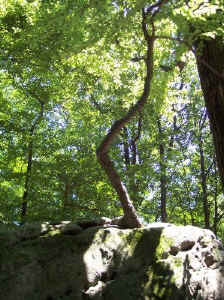
|
July 29, 2004
Today my uncle, Robert Frank and I visited
Beartown Rocks, in Jefferson County, Pennsylvania.
Beartown Rocks is a “Rock City.”
Here are found dozens of large blocks of sandstone, many
the size of houses, separated by open pathways.
Atop these blocks and clinging to the sides of these
blocks are a wide variety of trees, shrubs, and other plants.
Each block is like a small island resting on the forest
floor. The purpose
of the trip today was to photograph some of these forest
islands. |

|
Beartown Rocks is a small area within Clear Creek
State Forest, and managed by Clear Creek State Park.
It is located along Corbett Road about 3.5 miles
northeast of Sigel, Pa at GPS Coordinates: 41.30339°N 79.05948°W.
The area is in the Appalachian Plateau Province, a series
of long wavelength, low amplitude anticlines and synclines
trending northeast/southwest.
The tops on many of the hills in the region are capped by
the massively bedded, Pennsylvanian Age, Pottsville Sandstone/
Conglomerate. Massively
bedded means the individual beds are thick and the joints in the
beds are widely spaced. This
is the geologic formation exposed at Beartown Rocks.
Here the Pottsville beds are up to 40 feet thick.
This is a hard rock that is not easily weathered. |
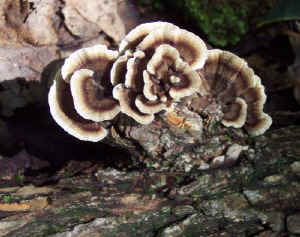
|
Landscape such as are present in this area
develop when a stream eventually breaches the hard caprock at
some point. Then
the stream rapidly cuts down through the softer rocks below.
As the stream cuts deeper the valley widens.
Pieces break off the
edge of the caprock and they are transported by mass wasting
process downslope toward the stream, eventually to be eroded and
transported away. At
this point surface erosion of the harder unit still continues
across its entire exposure, but is relatively slow compared to
the effects of the stream and the valley widening process.
The edge of the caprock essentially breaks off until the caprock protecting, “holding up the hill” is
all gone. Then once
the caprock is completely removed, the unprotected hill rapidly
erodes. A rock city
forms where 1) there is a massively bedded hard caprock, and 2)
there is just the right balance between rate of breakage from
the edge of the caprock unit and the rate at which the broken
pieces move downslope toward the stream. |
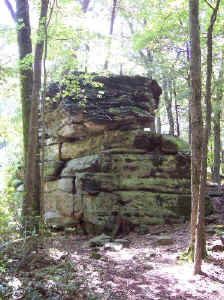
|
Beartown Rocks is a spectacular example of a rock
city. Other ones in
northcentral Pennsylvania include Panther Rocks, near Brockway
in Elk County, and Bilger’s Rocks, near Greensboro, in
Clearfield County. At
Bilger’s Rocks the pathways between the rocks are narrow tight
passages, barely wide enough to squeeze through.
At Beartown Rocks the gaps between the rock blocks are
measured in feet to tens of feet. |

|
None of the trees in the area are exceptionally
old, but I love the gnarled roots reaching down the sides of the
giant blocks to the forest floor below.
There are the tiny plants clinging and growing in narrow
crevices on the sides of the blocks.
The area is heavly populated by whitetail deer.
The vegetation on the forest floor shows the effects of
their browsing. It
is still healthy, but comparatively thin. On top of the sandstone blocks are a riot of growth.
There are small trees- birch, oak, maple.
There are massive thickets of mountain laurel and great
rhododendron. There
are profusions of ferns, mosses, lichens, and liverworts. |
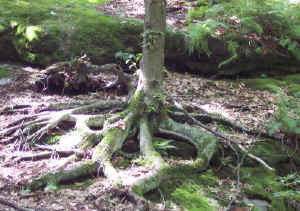
|
These photos do not do the site justice,
but give some idea of what I am talking about.
Beartown Rocks is a small site only a few acres in size,
but well worth the visit. The park has constructed a viewing platform atop one of the
boulders giving a nice view of the surrounding landscape. I plan to go back to the site until I get all of the
pictures I want. For
now these will have to do.
Ed Frank
All photographs by Edward Frank
|

|

Great Rhododendron growing in a small crevice.
|
|

|

Great Rhododendron
|
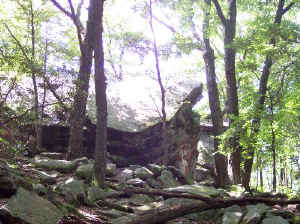
Robert Frank for scale.
|
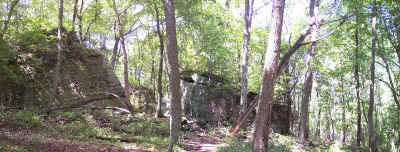
|